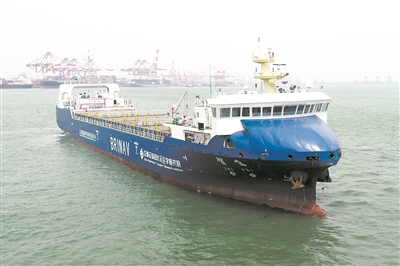China's 'Zhifei' Revolutionizes Smart Shipping

By CUI Shuang & LIANG Yilian
China's first autonomous 300TEU containership, the Zhifei, steers itself effortlessly into harbour near Aoshan Bay in Qingdao, Shandong Province, much to the amazement of onlookers recently. The Zhifei, which made its maiden voyage in April 2022, was completing a phased docking demonstration using one of its three driving modes — manned driving, remote driving, and unmanned driving. These modes enable the containership to realize the intelligent perception of its navigation environment, plan routes independently, avoid collisions intelligently, and be driven via remote control.
Breaking the data barrier
An advanced radar system is important to developing an intelligent driving system. Due to the fact that some well-known foreign radar brands are not open to China, the R&D team decided to develop and improve domestic radar with relevant enterprises. Over the period of a year, the R&D team and radar enterprise technicians were able to improve the effectiveness of data through continuous sea test measurements and equipment parameter adjustments.
"The team also specially developed a series of wave active suppression algorithms to clean out the wrong data caused by its error or electromagnetic interference, and make up for the lack of radar measurement accuracy," said Gao Jie, an official of Navigation Brilliance, a Qingdao-based smart ship technology company and one of the vessel’s developers.
Finding a way to secure communication
For intelligent driving, reliable communication is paramount. However, the R&D team found that due to the complexities of the marine environment, there was no single solution to avoiding signal loss.
“Just like you are making a phone call in a moving car, unconsciously, there are multiple base stations serving you continuously. But this is difficult to do on a mobile ship, because telecom operators have many blind spots in nearshore base station coverage, and signal delays, interruptions and losses can occur when base stations switch over,” said Yang Zongwei, deputy general manager of Navigation Brilliance.
Three major operators, China Telecom, China Mobile and China Unicom were consulted to work with the team to improve the base station coverage, adjust the antenna orientation, and optimize the network signal, to ensure that each part of the route is covered by an operator's base station.
For nearly four years, technicians tried to integrate various communication methods to find the optimal ratio of communication link data volume and cost.
At present, the Zhifei can receive stable and efficient signals and autonomously enter or leave a port in about ten minutes, after the integrated communication system had been perfected.
Explore battery technology
"Using pure electric propulsion has multiple advantages, especially when it comes to ship intelligence," said Zhu Shenchao, deputy general manager of Navigation Brilliance.
Zhu said that pure electricity can further shorten the response time of equipment and improve the accuracy of ship control, which is of great significance for intelligent driving.
The R&D team chose to use the on-board generator for charging which is both flexible and convenient, and can recycle excess power while sailing.
Battery expansion is one of the challenges the team encountered. After repeated trials and continuous optimization, they finally found an exclusive solution — through the right ratio of positive and negative battery materials, electrolytes, diaphragms and other raw materials, to increase the capacity of the battery unit to 80 and 90 amp hours, far beyond the traditional 50 amp hours.
"This alone is expected to save 10,000 RMB a day in operating costs for Zhifei," said Zhu.
Meanwhile, Zhang Baochen, executive vice chairman of the China Institute of Navigation told Science and Technology Daily that the intelligent and green innovation practice of the "Zhifei" will propel China's intelligent ships to navigate confidently through future challenges.






